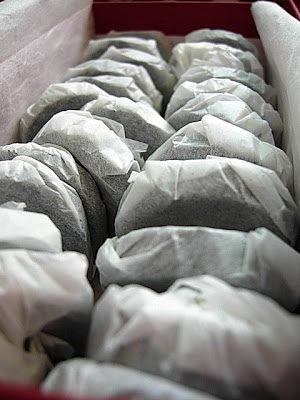
One received this tea as a gift from a friend who received it from another as a gift. He knew absolutely nothing about this tea except that it was traditional style ddok cha. He said that it probably came from the Jiri mountain area but even that was just mere speculation. The only thing that one knows for sure is that it came with kindness in a red box.

Opening the red box and removing the thin white rice paper which veils its contents below reveals a strong smell of slightly medicinal spicy cinnamon and two long quaint rows of tiny coin-shaped ddok cha cakes all individually rapped in rice paper. The scent of anything resembling tea is lost in the spicy blanket of odours. One takes up a single coin, unwraps it, breaks it into smaller chunks, and drops it into the bottom of the tea pot. Soon near boiling water embraces these pieces and the resulting infusion is poured into a serving pot then from a serving pot into small ceramic cups.

This tea fills ones mouth with a simple, very watery, flat, sweet, clear cinnamon taste. This tea is probably the very opposite of complex and doesn't hardly change at all from infusion to infusion other than conjuring a bit more astringency. The faint aftertaste mirrors the initial taste- a testament to its simplicity.

When two cakes are added as opposed to just one this tea is much more enjoyable as a bit more astringency pushes this tea to a more complete, yet incomprehensibly simple, feeling and taste in one's mouth.

One basks in and gives thanks to this tea's uncut, transparency.
Peace

7 comments:
Matt, how large are those coins? You used up two for one session, so I suppose they aren't 100 grams like the last ones were.
Thomas,
They are a little bigger than a U.S. quarter.
This is the most common, traditional size of ddok cha.
Peace
it looks very funny , how the leaves are pressed , a little bit like an humburger ....
Ginkgo,
They also reminded me of hamburger patties. Mmmm... Hambuger Tea...
Hahhaaha.
Peace
Matt, I bought some Hadong bal-ho cha, a green tea that is halfway between an oolong and black.
http://www.radicalcontrapositions.com/left_flank/2008/10/25/how-to-enjoy-black-tea-in-a-green-tea-nation/
How is this ddok tea related to this bal-ho cha?
Baltimoron,
The tea you have there is a bal-ho cha. Bal-ho means 'fermented' in Korean and is the word used to describe how they make kimchi by fermenting cabbage (bal ho kimchi). 'Fermented' is actually the wrong term it should actually be 'oxidized'. The term 'bal-ho' is a new term to describe this tea. This term has been likely adopted to capitalize on the 'health wave' believed to come from fermented and oxidized products in Korea.
This tea is actually quite a new invention in Korea and likely came about in the last thirty years or so, with tea producers looking for variety. Its traditional name is yellow tea or hwang cha, which alludes to its yellowish-orange liquor. This blog either refers to it as yellow tea or as semi-oxidized tea.
The tea you have as well as the semi-oxidized Korean teas featured on this blog are different than ddok cha in that they undergo a different production method. The semi-oxidized teas undergo about a week of sitting in a warm room left to 'oxidize' unlike the few days that ddok cha undergoes. Besides this difference there are probably others of which one doesn't exactly know, either way, the production of semi-oxidized teas and ddok cha are different.
Peace
Thanks, Matt
Post a Comment